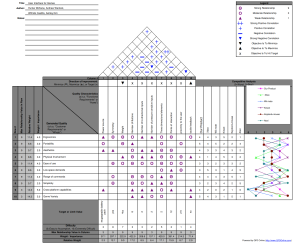House of Quality Tool for Needs and Specification Managment
The House of Quality (HOQ)
The House of Quality (HOQ) is a tool that helps designers relate and validate the connections between stakeholder needs and design specifications or engineering requirements. It is a matrix that shows the relationship between what the customers want and how the product can meet those wants. The HOQ also helps designers to compare their product with competitors and identify areas for improvement.

An Excel-based Template is available from the following website (among many others as well).
QFD Online – Free House of Quality (QFD) Templates for Excel
The HOQ has six main parts:
– Customer requirements: These are the needs and expectations of the customers, expressed in their own words. This is sometimes called the “Voice of the Customer”
– Engineering characteristics: These are the measurable attributes of the product that affect its performance and quality. They can be derived from technical standards, specifications, regulations, etc.
– Relationship matrix: This is the core of the HOQ, where the customer requirements and engineering characteristics are linked. Each cell in the matrix indicates how strongly an engineering characteristic affects a customer requirement. The strength of the relationship can be rated using symbols, numbers, or colors.
– Correlation matrix: This is a smaller matrix at the top (or roof) of the HOQ, where the engineering characteristics are compared with each other. Each cell in the matrix shows how positively or negatively two engineering characteristics correlate. The correlation can be indicated using symbols, such as +, -, or 0.
– Competitive assessment: This is a section at the bottom of the HOQ, where the product is evaluated against its competitors based on the customer requirements and engineering characteristics. The evaluation can be done using symbols, such as ○, △, or ×, or numbers, such as 1 to 5.
– Technical assessment: This is a section at the right of the HOQ, where the engineering characteristics are prioritized based on their importance and difficulty. The importance can be calculated by multiplying the relationship matrix ratings by the customer requirements weights. The difficulty can be estimated by considering factors such as cost, time, feasibility, etc.
The process for filling out the HOQ can be summarized as follows:
- Define the scope and objective of the design project.
- Identify and prioritize the customer requirements using various methods and sources.
- Identify and define the engineering characteristics that can satisfy the customer requirements.
- Fill in the relationship matrix by rating how each engineering characteristic affects each customer requirement.
- Fill in the correlation matrix by rating how each engineering characteristic correlates with each other.
- Fill in the competitive assessment by evaluating how the product and its competitors perform on each customer requirement and engineering characteristic.
- Fill in the technical assessment by calculating the importance and estimating the difficulty of each engineering characteristic.
- Analyze and interpret the results of the HOQ and use them to guide further design decisions and actions.
Instructions for Completing a House of Quality
Industry Interview – What is Voice of the Consumer and How is it Used?

